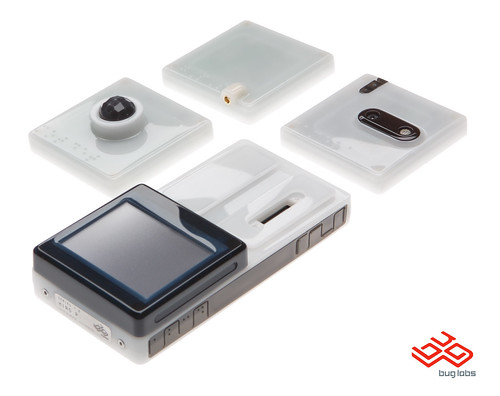I just recently got my BUG developer hardware from Bug Labs and have begun to work with it. The idea: a Linux-powered, open source mini computer with little modules you snap on and off like Lego bricks to form whatever gadget you want. It has a lovely development environment, connects intelligently to the Web, and has some significant power behind it, but the real usefulness is in its modules. That makes today’s announcement more important, because the BUG gets some really interesting modules:
- BUGprojector, 480×320 pico-projector with TI DLP inside. 9 lumens, but then the thought of doing a performance for three close friends is kind of nice … like VJing in a closet somewhere.
- BUGsound, audio input / output and speaker, with internal audio processing on the hardware itself. Just got the dev module of this.
- BUG GSM, for unlocked 3G phone capabilities – GSM, text, the lot.
- BUGwifi: 802.11b/g + Bluetooth 2.0, which allows both wireless connections with computers and gadgets and connectivity with Bluetooth hardware (like headsets)
- BUGbee: 802.15.4 radio for short-range networking – often superior to 802.11b/g for certain applications.
Unfortunately, that’s all we know, because pricing, specs, availability, info, and even photos of most of this aren’t yet available. Fortunately, I live a short subway ride away from BUG Labs, so I hope to have details.
Add these to current modules with accelerometers, proximity sensors, GPS positioning, a touchscreen, camera (still/video), and even a new vonHippel module that turns this into an I/O device for sensors and robotics (and can even connect to Arduino).
Bug Labs Announces New BUGmodules and Applications at CES 2009 [Bug Labs]
I think there are powerful possibilities for what BUG describes as “hardware mash-ups,” and in the context of the CDM sites, unusual new concepts for performance, installation, and mobile art. The only challenge I see is that even with these snap-on modules, the capabilities of the Google Android platform or a small laptop pose a considerable threat. That’s not to say it’s an either/or choice, though, as there are strengths and weaknesses to each, so it really depends on the project. I hope to show off a bit more of what this means practically and creatively soon, and you can bet I’ll be watching for more module details – particularly that projector.
In fact, BUG, any chance of the projector as a hackable standalone, too, and some sort of video out on the BUG?
Who’s von Hippel? Why, it’s Eric von Hippel of MIT. Here’s what he has to say about democratizing innovation (well, beyond what you have to buy his book for). It really cuts to the heart of what this gadget is all about.

